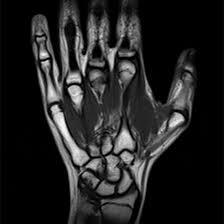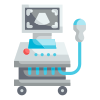Fill out form to enquire now
MRI For Left Hand
Medintu has collaborated with the best pathology laboratories that are NABL and NABH certified and follow ISO safety guidelines to provide the best MRI For Left Hand at an affordable price for needy individuals. An MRI for the left hand is a non-invasive imaging procedure that uses powerful magnets, radio waves, and a computer to produce detailed images of the structures within your hand. It is an advanced diagnostic tool that helps healthcare providers assess both soft tissues (like muscles, tendons, and ligaments) and bones in the hand, providing a clearer picture of conditions that might not be visible on X-rays or other imaging methods. Whether you’re experiencing persistent pain, swelling, numbness, or have recently sustained an injury, an MRI of the left hand can help pinpoint the cause. It’s particularly valuable for diagnosing issues that affect the delicate structures of the hand, such as tendon tears, nerve compression, joint problems, fractures, or tumors. Unlike X-rays or CT scans, MRI does not use ionizing radiation, making it a safe and effective option for evaluating your hand’s health. It’s often recommended when more detailed information is needed to make an accurate diagnosis and to guide treatment decisions. Whether for acute injuries or chronic conditions, MRI is a vital tool that enables doctors to provide the most appropriate care for your hand.
To schedule an appointment for a MRI For Left Hand, simply contact Medintu or call our customer care at +919100907036 or +919100907622 for more details and queries.
Why MRI for Left Hand Used?
An MRI (Magnetic Resonance Imaging) for the left hand is typically used to diagnose and evaluate various medical conditions related to the bones, muscles, tendons, ligaments, nerves, and other soft tissues in the hand. Some common reasons for ordering an MRI for the left hand include:
- Injuries and Trauma
Fractures: MRI can detect fractures in bones that may not show up clearly on an X-ray.
Ligament or Tendon Damage: It can identify tears or strains in ligaments or tendons (e.g., in conditions like sprains, strains, or ruptures).
- Arthritis
Osteoarthritis: MRI can assess joint degeneration, cartilage loss, and bone changes due to arthritis.
Rheumatoid Arthritis: It can also detect inflammation, joint damage, and soft tissue involvement associated with autoimmune diseases.
- Nerve Compression or Damage
Carpal Tunnel Syndrome: An MRI can reveal nerve compression or other issues like swelling around the median nerve, which can cause numbness and pain in the hand.
- Infections and Inflammation
Infections: MRI can detect soft tissue or bone infections (like osteomyelitis or septic arthritis) that may affect the hand.
Tendon or Joint Inflammation: It can help visualize conditions like tenosynovitis (inflammation of the tendon sheaths) or bursitis (inflammation of fluid-filled sacs near joints).
- Tumors and Cysts
Benign or Malignant Tumors: MRI can identify the presence of tumors, cysts, or other growths within the hand that could cause pain, swelling, or limited movement.
- Blood Flow Issues
Vascular Disorders: MRI can help identify problems with blood vessels, such as blocked arteries or venous insufficiency, which can affect the hand.
- Congenital Abnormalities
MRI can also be used to evaluate congenital conditions in the hand, such as abnormal bone development or joint malformations that may affect function.
How MRI for Left Hand Works?
An MRI (Magnetic Resonance Imaging) for the left hand works by using strong magnetic fields, radio waves, and computer technology to create detailed images of the internal structures of the hand, including bones, muscles, tendons, ligaments, nerves, and soft tissues. Unlike X-rays or CT scans, MRI does not use ionizing radiation. Here’s a step-by-step explanation of how an MRI of the left hand works:
- Magnetic Field and Radio Waves
Magnetic Field: When you enter the MRI machine, you are surrounded by a strong magnetic field. This magnetic field causes the hydrogen atoms in your body to align with the magnetic field.
Radio Waves: Once the hydrogen atoms are aligned, the MRI machine sends a pulse of radiofrequency (RF) waves into the body.
- Atom Relaxation and Signal Detection
After the radiofrequency pulse is turned off, the hydrogen atoms in your tissues begin to return (relax) to their original alignment within the magnetic field. As they relax, they release energy in the form of signals.
Different tissues in your hand contain varying amounts of water, and therefore, they emit different signals as the hydrogen atoms relax.
- Imaging and Data Collection
The MRI machine has special sensors that detect these signals as the hydrogen atoms relax.
The signals are then sent to a computer, which processes the data to create detailed, high-resolution images of the internal structures of the left hand.
- 3D Imaging
Modern MRI machines can take multiple 2D “slices” of the hand from different angles. These slices can then be reconstructed into 3D images, allowing the radiologist or doctor to examine the hand in three dimensions.
MRI images can show fine details of soft tissues, which is particularly useful for evaluating ligaments, tendons, muscles, and nerves, as well as detecting inflammation, injury, or disease.
- The MRI Machine
You will be asked to lie down on a table, and your left hand will be positioned inside the MRI machine. You may be asked to keep the hand still to avoid blurring the images.
The MRI machine makes loud knocking or tapping noises during the scanning process, so you may be given earplugs or headphones to reduce the noise.
Common Conditions Diagnosed with MRI for Left Hand
An MRI of the left hand is commonly used to diagnose a variety of conditions affecting the bones, joints, soft tissues, nerves, and blood vessels. Here are some of the most common conditions that can be diagnosed with an MRI of the left hand:
- Fractures and Bone Injuries
Stress Fractures: MRI can detect small or subtle fractures that may not be visible on X-rays, especially in the case of stress fractures or hairline cracks in the bones.
Bone Contusions: MRI is useful for identifying bone bruises or contusions caused by trauma.
- Arthritis
Osteoarthritis (OA): MRI can provide detailed images of joint degeneration, cartilage thinning, and bone spurs associated with OA. It can also show synovial inflammation and joint effusion (fluid buildup).
Rheumatoid Arthritis (RA): MRI is helpful for detecting inflammation of the synovial lining (synovitis), bone erosions, and soft tissue swelling seen in RA. Early joint changes can be detected more clearly with MRI than with X-rays.
- Tendon and Ligament Injuries
Tendon Tears: MRI is very effective for visualizing partial or complete tears of tendons, such as in conditions like De Quervain’s tenosynovitis (inflammation and thickening of tendons in the wrist and thumb) or flexor tendon injuries.
Ligament Sprains and Tears: Ligament injuries such as those in the thumb or wrist can be assessed in detail with MRI. Tears, strains, and inflammation of ligaments are clearly visible.
- Nerve Compression and Entrapment
Carpal Tunnel Syndrome: MRI can identify compression of the median nerve at the wrist, caused by swelling of the surrounding tissues or abnormal narrowing of the carpal tunnel. It helps evaluate the severity of nerve involvement and other associated soft tissue changes.
Ulnar Nerve Compression: MRI can also show ulnar nerve entrapment, especially at the elbow or in the wrist (Guyon’s canal), which might cause pain or numbness in the hand.
- Soft Tissue Injuries and Inflammation
Bursitis: MRI can show inflammation of the bursae (small fluid-filled sacs that cushion joints), which can cause pain and swelling in the hand and wrist.
Synovitis: MRI can detect inflammation of the synovial membrane (lining the joints), which is often seen in inflammatory conditions like rheumatoid arthritis or gout.
Benefits of MRI for Left Hand
MRI (Magnetic Resonance Imaging) offers several distinct benefits when used to evaluate the left hand, making it an essential tool for diagnosing a wide range of conditions affecting the bones, muscles, tendons, ligaments, nerves, and other soft tissues. Here are the main benefits of using MRI for the left hand:
- Non-Invasive and Safe
No Ionizing Radiation: Unlike X-rays or CT scans, MRI does not use ionizing radiation, making it a safer option, especially for individuals who may require multiple scans over time, or for those who are pregnant or have a high sensitivity to radiation.
Non-invasive: The procedure is non-invasive, meaning no surgical incisions or invasive techniques are required to obtain detailed images of internal structures.
- Detailed Soft Tissue Imaging
Clear Imaging of Soft Tissues: MRI is particularly valuable for imaging soft tissues, such as tendons, ligaments, muscles, nerves, and cartilage. These tissues are often difficult to see on X-rays or CT scans. For conditions like tendon tears, ligament sprains, nerve compression, and soft tissue tumors, MRI provides highly detailed images that are crucial for accurate diagnosis.
- High-Resolution Images
High-Resolution Imaging: MRI provides excellent resolution, allowing for detailed visualization of both the structure and potential abnormalities in the hand’s bones, joints, and soft tissues. This high level of detail is important for diagnosing conditions like arthritis, fractures, infections, and tumors.
- Effective for Diagnosing Complex Conditions
Complex Joint and Soft Tissue Injuries: MRI is particularly helpful for diagnosing complex conditions such as joint injuries, tendon or ligament tears, or nerve damage that may be missed on simpler imaging tests.
- Diagnosis of Inflammatory and Autoimmune Conditions
Inflammation and Infection: MRI can help identify inflammatory conditions such as rheumatoid arthritis, psoriatic arthritis, or gout, and can show early signs of joint damage or soft tissue involvement before they are visible on X-rays. It can also help detect infections in the bones (osteomyelitis) or joints (septic arthritis).
- Detection of Tumors and Cysts
Soft Tissue Tumors: MRI is sensitive in detecting soft tissue tumors, both benign and malignant, in the hand. This includes common tumors like ganglion cysts, lipomas, and rarer tumors like synovial sarcomas. MRI can differentiate between these types of growths and other soft tissue abnormalities.
- Test Type: MRI For Left Hand
- Preparation:
- Wear a loose-fitting cloth
- Fasting not required
- Carry Your ID Proof
- Prescription is mandatory for patients with a doctor’s sign, stamp, with DMC/HMC number; as per PC-PNDT Act
- Reports Time: With in 4-6 hours
- Test Price: Rs.4500
How can I book an appointment for a MRI For Left Hand through Medintu?
To schedule an appointment for a MRI For Left Hand, simply contact Medintu or call our customer care at +919100907036 or +919100907622 for more details and queries.
What is an MRI for the left hand?
An MRI (Magnetic Resonance Imaging) for the left hand is a diagnostic procedure that uses strong magnets and radio waves to create detailed images of the bones, muscles, tendons, ligaments, and nerves in your hand. It helps doctors diagnose conditions such as fractures, tendon injuries, arthritis, and nerve issues.
Is MRI for the left hand painful?
No, an MRI is generally painless. The procedure is non-invasive, and while you may feel discomfort from having to remain still for an extended period, the scan itself does not cause pain.
How long does an MRI of the left hand take?
An MRI of the left hand typically takes between 30 to 45 minutes, depending on the complexity of the scan. If contrast is used to enhance the images, the procedure may take slightly longer.
Do I need to prepare for an MRI of the left hand?
Preparation is simple. You may be asked to remove any metal objects such as jewelry, watches, or zippers, as they can interfere with the magnetic field. It’s best to wear comfortable clothing without metal parts. If a contrast dye is needed, you may be asked about any allergies or kidney issues before the procedure.
Is MRI for the left hand safe?
Yes, MRI is generally considered very safe. It does not involve radiation, unlike X-rays or CT scans. However, if you have metal implants, a pacemaker, or other devices in your body, you should inform your doctor, as some implants may interfere with the MRI.
What conditions can an MRI of the left hand diagnose?
MRI can diagnose a variety of conditions affecting the left hand, including:
- Fractures (including stress fractures and complex breaks)
- Tendon or ligament injuries (tears, sprains)
- Arthritis (osteoarthritis or inflammatory arthritis)
- Nerve compression (such as carpal tunnel syndrome)
- Soft tissue tumors or cysts
- Swelling, fluid buildup, or infections
Do I need a contrast agent for the MRI?
In some cases, a contrast agent (dye) may be used to enhance the images, especially if your doctor wants to get a clearer view of specific tissues, blood vessels, or tumors. Your healthcare provider will inform you if this is necessary prior to the MRI.
Will I get results right after the MRI?
While the MRI will be conducted right away, the results are reviewed by a radiologist, who will generate a report that is sent to your doctor. Your doctor will discuss the findings with you during a follow-up appointment, usually within a few days.
Why Choose Medintu for MRI For Left Hand?
Medintu is an online medical consultant that provides home-based medical services not only in your area but also in most cities in India, including Hyderabad, Chennai, Mumbai, Kolkata, and more. We have collaborated with diagnostic centers that have the best machines and equipment to ensure you get accurate results. Medintu provides 24-hour customer service for booking the appointment of the services and guides you with instructions. Medintu also provides the best diagnostic centers at low prices. Once you receive your test results, you can easily book an appointment with our network of experienced doctors for consultation. To schedule an appointment for a MRI For Left Hand, simply contact Medintu or call our customer care at +919100907036 or +919100907622 for more details and queries.





